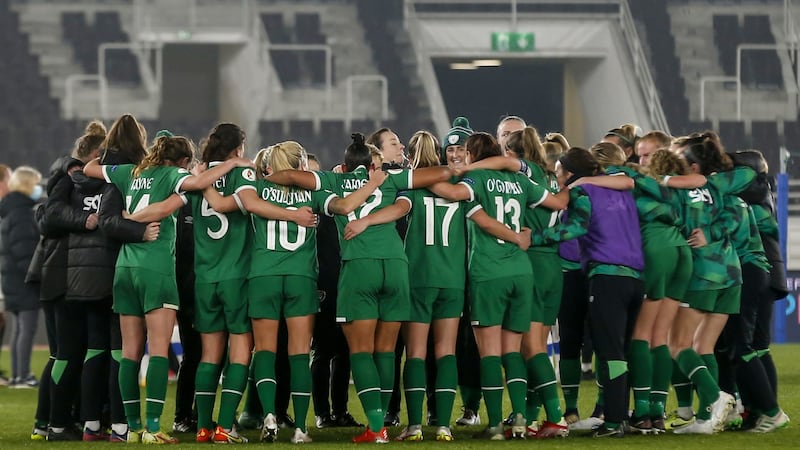Just like last week proved so pivotal for the FAI and the Republic of Ireland men’s national teams, the upcoming international window bears the brunt of showing that the women’s game in this country is evolving.
Qualification for a major tournament did not hinge on the results of Stephen Kenny’s charges, but for Vera Pauw’s squad, a six-point return feels essential when Slovakia come to Tallaght next Thursday before Georgia’s arrival on Tuesday week to a stadium that Katie McCabe’s squad consider to be their home.
For now, anyway.
Some day, in the not too distant future, McCabe will lead Ireland out at the Aviva Stadium. It’s the investment that will generate the profit.
The women’s team have a genuine chance of qualifying for the 2023 World Cup in Australia and New Zealand. Despite a narrow, but potentially crucial low-scoring 1-0 defeat to runaway group favourites Sweden last month, the 2-1 victory in Helsinki makes everything seem possible.
Back-to-back home wins would reinforce the performance against Finland and leave the Girls in Green in a superb position after four games. It’s the way they are gelling by working for each other that has been so impressive in recent matches.
And just like the sell-out crowd for the men’s match against Portugal, we can expect close to full capacity in Tallaght Stadium for these November internationals.
When I worked at Chelsea, post-match mingling with fans was a ritual in the Women’s Super League that struck me the most, as players took as much time as was necessary to pose for photos, sign autographs and connect with a generation that will be so inspired by the brief interaction.
The same tradition now exists in Tallaght Stadium after internationals as young supporters, boys and girls, line the pitchside barriers in eager anticipation of a moment with the players.
It costs nothing to do it, but its value is infinite.
The hugely successful “Can’t See, Can’t Be” 20x20 initiative has been defiantly rebranded as “Can See, Can Be,” as the women’s game globally has finally morphed into a powerful entity that will only continue to grow.

Last weekend, the final series of games in the Women’s National League captured an audience that has never been reached before, as TG4 broadcast the dramatic events in Greenogue and Tolka Park.
Title favourites Peamount United succumbed in dramatic fashion to a Galway side that announced themselves as a force to be reckoned with come next season, while a curious subplot unfolded in Tolka Park as Shelbourne saw off Wexford Youths in a precursor to Sunday’s FAI Cup final.
Most telling, though, was the engagement with unfolding events on social media as Twitter, in particular, was alive with posts relating to both games. Traditional supporters of women’s football were there, as they always are, but there were many new voices or, more accurately, established voices who have decided to take an interest.
Prominent journalists and footballers, along with members of the general public, were hugely engaged as clips of goals, scores and permutations were shared and discussed.
It further proves that by providing coverage and visibility before responding to the demand, an appetite can be created.
Again, it’s the investment that will generate the profit.
The commentary on Shels’ title success, and Peamount’s unfortunate collapse, even spilled into RTÉ’s coverage of the under-21 men’s win over Sweden on Tuesday night, when I thought Áine O’Gormon showed grace and professionalism.
The FAI Cup final will be televised live on RTÉ 2 this Sunday and it’s important to recognise the exposure that women’s football now receives.
In a year where female sport has graduated from the ‘women’s section’ to lead back page headlines and onwards to dominating the front pages, for all the right reasons too I must add, there is finally a coming of age where female sport stands on its own two feet, holding its ground in the sporting conversation on merit.
Women’s sport is no longer expected to be grateful for the crumbs it has been fed in the past. There’s now a groundswell of support around the few that fought for basic recognition, as a new generation of parents demand better for their daughters whilst becoming conscious of their own previous bias.
What’s more, they are starting to challenge that bias in others.
League of Ireland clubs have begun to recognise the potential of a properly resourced women’s team – on a commercial level – as opposed to the burden of them.
The lens through which the game here is being viewed is changing and the women’s national team are the flag-bearers of this new era.
Yet aside from all those reasons and the wider discussion, Pauw's charges can go into this double-header knowing they have what it takes to win. In Helsinki, their collective belief surged through Denise O'Sullivan, Heather Payne, Courtney Brosnan and, as always, McCabe's every contribution.
After a series of defeats against tough teams, Ireland proved that they possess the capacity to turn harsh lessons into performances that generate results.
The 3-2 friendly victory over Australia was a case in point, but more so the win over a higher-ranked Finland.
Now Ireland must show they can win games as the favourites. Against Sweden and the Finns they were underdogs but this team has higher aspirations. And that’s mainly because they can see what they want to be.
















